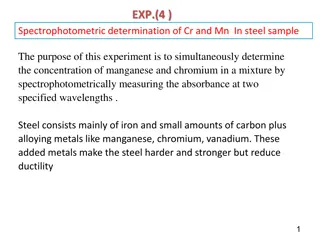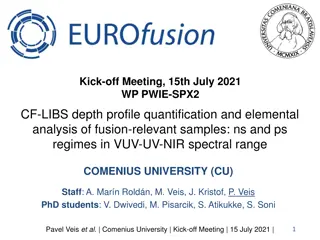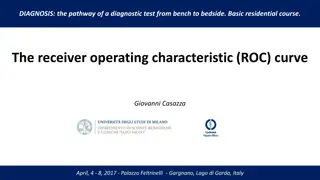Understanding ROC Analysis in Classification of Biological Samples
Differentially expressed genes can be utilized to categorize biological samples as responder or non-responder to treatments. Receiver Operating Characteristics (ROC) analysis is a method to evaluate classification performance based on sensitivity, specificity, true positive rate, and false positive rate. Sensitivity and specificity are crucial for determining the optimal cutoff point on a ROC curve to balance between these parameters. The area under the ROC curve (AUC) indicates how well the test distinguishes between groups, with a larger AUC suggesting better predictive ability. Additionally, the Mann-Whitney U test is mentioned as a non-parametric alternative for comparing two groups.
Download Presentation

Please find below an Image/Link to download the presentation.
The content on the website is provided AS IS for your information and personal use only. It may not be sold, licensed, or shared on other websites without obtaining consent from the author. Download presentation by click this link. If you encounter any issues during the download, it is possible that the publisher has removed the file from their server.
E N D
Presentation Transcript
Background Differentially expressed genes can be used to classify biological samples into categories as: Responder Non-responder Classification is not always unequivocal, because the gene expression values often overlap One of the methods to assess the performance of a classificator is the Receiver Operating Characteristics (ROC) analysis
How to measure the performance of classification? Sensitivity is the proportion of those who are categorized as responder to a treatment and correctly identified as positive by the test. Treatment response responder non-responder total positive a b a+b Specificity is the proportion of those who are categorized as non-responder and correctly identified as negative by the test. Test result negative c d c+d total a+c b+d N True positive rate is equal to sensitivity. Sensitivity = True positive rate = a/(a+c) False positive rate is the proportion of those who are categorized as non-responder but are identified as positive by the test. Specificity = d/(b+d) False positive rate=b/(b+d)=1-specificity
How to interpret sensitivity and specificity? As there is a trade-off between sensitivity and specificity, one can a ROC curve to find an optimal cutoff point which maximizes both sensitivity and specificity. In a ROC plot, sensitivity (true positive rate) is plotted on the Y axis, and 1-specificity (false positive rate) on the X axis. A ROC plot shows us all possible thresholds. Each point indicates a different cutoff and gives a different combination of sensitivity and specificity. The dotted line shows where the test would fail if the results were no better than chance at predicting the treatment response
Strongest cutoff point We can find the strongest cutoff point close to the top of the left corner. Here, sensitivity (true positive rate) is optimized and 1- specificity (false positive rate) is minimized.
Area Under Curve (AUC) AUC shows how well the test separates the two groups. The larger the area under the ROC curve, the more useful is the measurement to predict treatment response. AUC - 0.6 AUC 0.6 0.7 AUC 0.7 0.8 AUC 0.8+ Effect is small for clinical utility. A cancer biomarker with potential clinical utility. Top quality cancer biomarker. Blockbuster biomarker.
Second test: Mann- Whitney U test The Mann-Whitney U test is a rank-based non- parametric test. One can use it to determine if there are differences between two groups. Compare to two-sample t-test, the Mann-Whitney test has limited assumptions: groups are independent of each sample in one group only Normal distribution of the sample is not an assumption. We usually present characteristics of the groups by employing a box-and-whisker plot.
ROC Plotter example Based on AUC=0.825, the gene classified treatment response effectively. ROC curve is significant (p-value < 1e-16) Strongest cutoff calculated determined as 245 Sensitivity is 0.81 Specificity: 1-0.22 = 0.78 Based on Mann-Whitney U test, the differences in gene expression between responders and non- responders is significant (p-value 4.1e-18)























